Corporate Accounting and Financial Reporting Analysis
VerifiedAdded on 2023/06/04
|12
|2962
|370
Report
AI Summary
This report provides a comprehensive analysis of corporate accounting, encompassing corporate regulations, the process of setting accounting standards, and detailed examinations of equity components within four publicly listed companies on the ASX: Evolution Mining, BHP Billiton, Rio Tinto, and Altura Mining. The report critically discusses the necessity of regulating financial accounting and reporting versus allowing voluntary disclosure by managers, highlighting the advantages and disadvantages of each approach. It explores the role of the Australian Accounting Standards Board (AASB) in global standard setting, including its contributions to the International Accounting Standards Board (IASB) and the adoption of International Financial Reporting Standards (IFRS). Furthermore, the report delves into the specifics of equity items, such as issued capital, reserves, and accumulated losses, for each of the selected companies. It also provides a comparative analysis of debt and equity, offering a clear understanding of their proportions within the financial structures of the studied entities, which is crucial for investment decisions and assessing financial health.
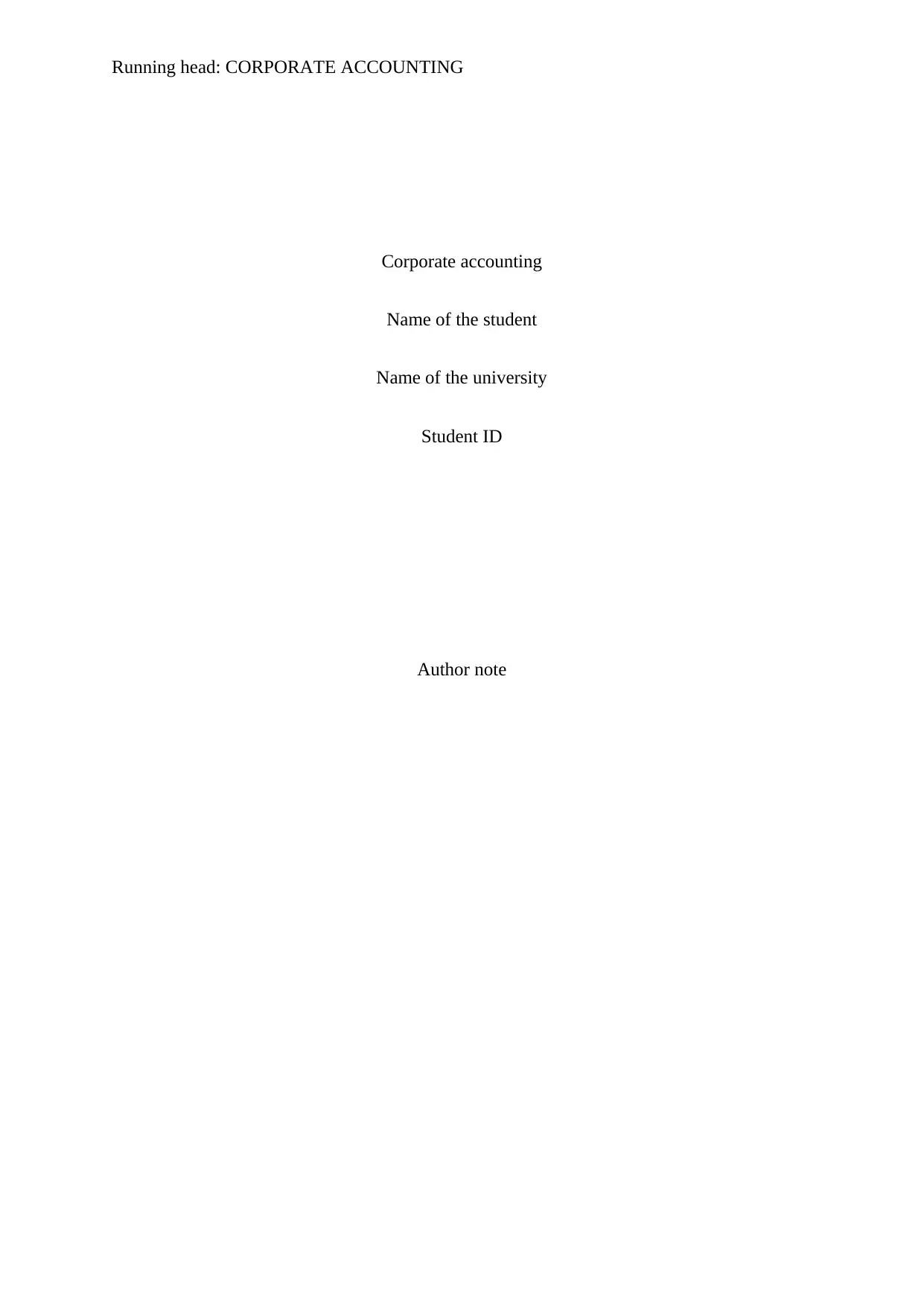
Running head: CORPORATE ACCOUNTING
Corporate accounting
Name of the student
Name of the university
Student ID
Author note
Corporate accounting
Name of the student
Name of the university
Student ID
Author note
Paraphrase This Document
Need a fresh take? Get an instant paraphrase of this document with our AI Paraphraser
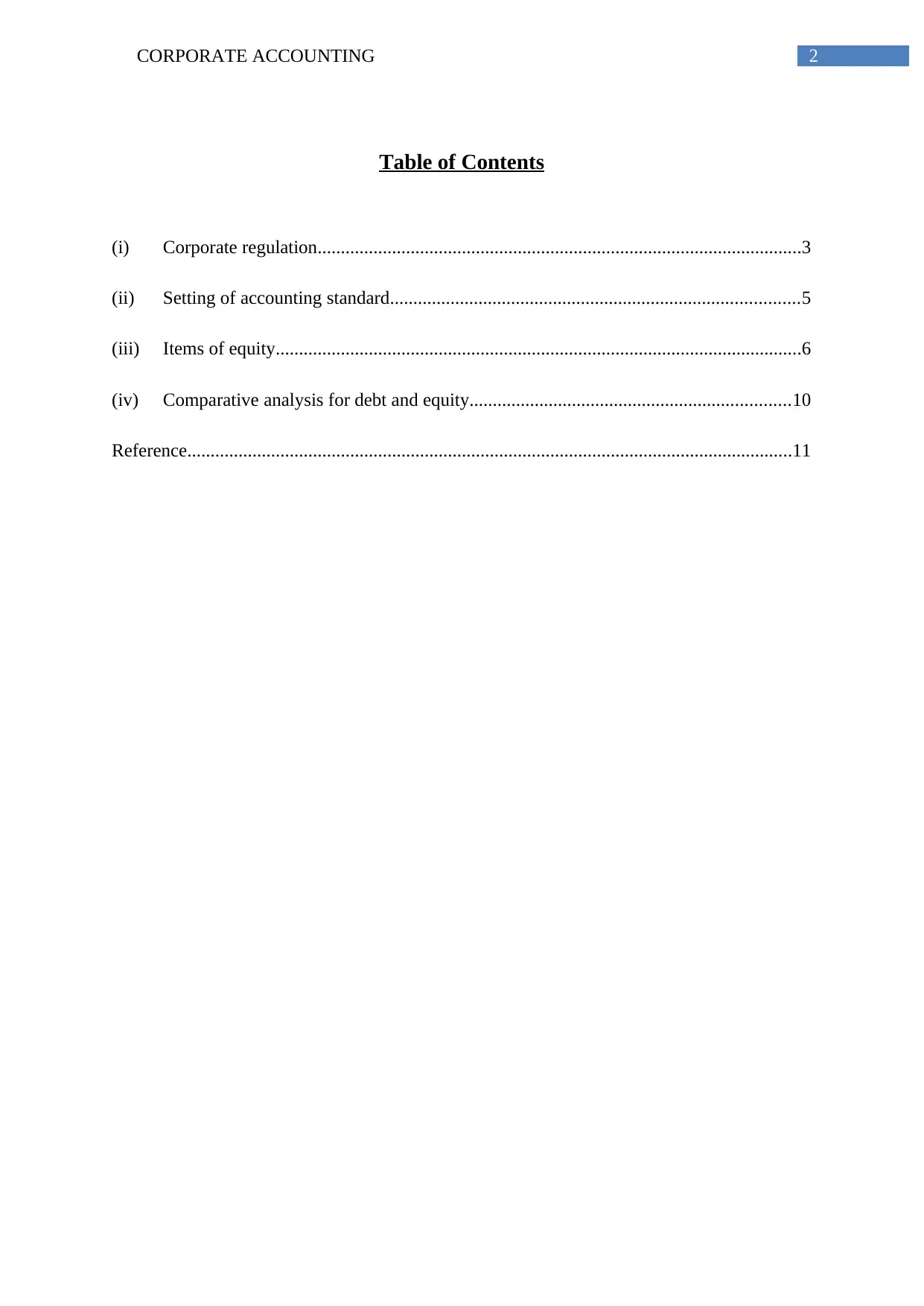
2CORPORATE ACCOUNTING
Table of Contents
(i) Corporate regulation........................................................................................................3
(ii) Setting of accounting standard........................................................................................5
(iii) Items of equity.................................................................................................................6
(iv) Comparative analysis for debt and equity.....................................................................10
Reference..................................................................................................................................11
Table of Contents
(i) Corporate regulation........................................................................................................3
(ii) Setting of accounting standard........................................................................................5
(iii) Items of equity.................................................................................................................6
(iv) Comparative analysis for debt and equity.....................................................................10
Reference..................................................................................................................................11
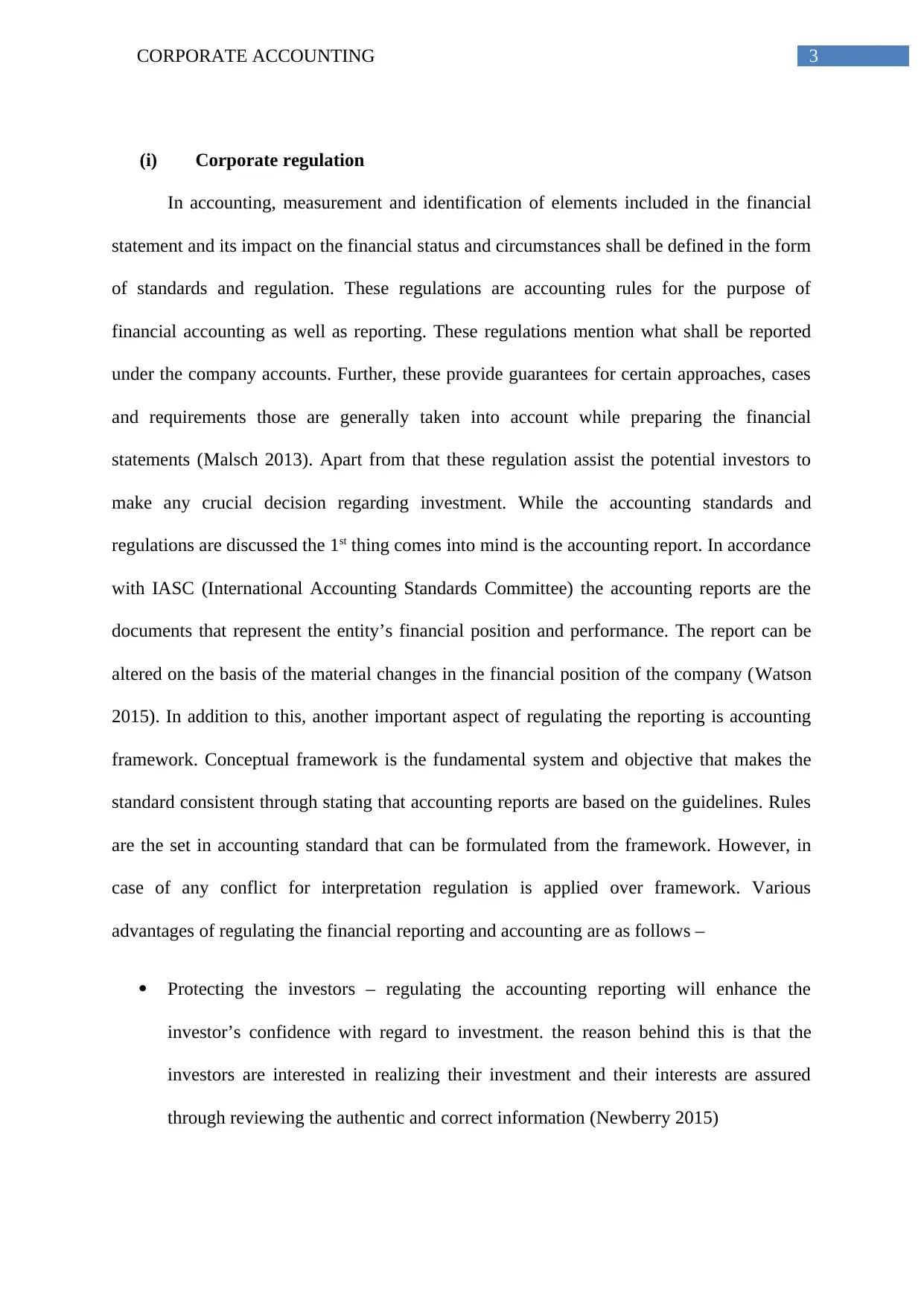
3CORPORATE ACCOUNTING
(i) Corporate regulation
In accounting, measurement and identification of elements included in the financial
statement and its impact on the financial status and circumstances shall be defined in the form
of standards and regulation. These regulations are accounting rules for the purpose of
financial accounting as well as reporting. These regulations mention what shall be reported
under the company accounts. Further, these provide guarantees for certain approaches, cases
and requirements those are generally taken into account while preparing the financial
statements (Malsch 2013). Apart from that these regulation assist the potential investors to
make any crucial decision regarding investment. While the accounting standards and
regulations are discussed the 1st thing comes into mind is the accounting report. In accordance
with IASC (International Accounting Standards Committee) the accounting reports are the
documents that represent the entity’s financial position and performance. The report can be
altered on the basis of the material changes in the financial position of the company (Watson
2015). In addition to this, another important aspect of regulating the reporting is accounting
framework. Conceptual framework is the fundamental system and objective that makes the
standard consistent through stating that accounting reports are based on the guidelines. Rules
are the set in accounting standard that can be formulated from the framework. However, in
case of any conflict for interpretation regulation is applied over framework. Various
advantages of regulating the financial reporting and accounting are as follows –
Protecting the investors – regulating the accounting reporting will enhance the
investor’s confidence with regard to investment. the reason behind this is that the
investors are interested in realizing their investment and their interests are assured
through reviewing the authentic and correct information (Newberry 2015)
(i) Corporate regulation
In accounting, measurement and identification of elements included in the financial
statement and its impact on the financial status and circumstances shall be defined in the form
of standards and regulation. These regulations are accounting rules for the purpose of
financial accounting as well as reporting. These regulations mention what shall be reported
under the company accounts. Further, these provide guarantees for certain approaches, cases
and requirements those are generally taken into account while preparing the financial
statements (Malsch 2013). Apart from that these regulation assist the potential investors to
make any crucial decision regarding investment. While the accounting standards and
regulations are discussed the 1st thing comes into mind is the accounting report. In accordance
with IASC (International Accounting Standards Committee) the accounting reports are the
documents that represent the entity’s financial position and performance. The report can be
altered on the basis of the material changes in the financial position of the company (Watson
2015). In addition to this, another important aspect of regulating the reporting is accounting
framework. Conceptual framework is the fundamental system and objective that makes the
standard consistent through stating that accounting reports are based on the guidelines. Rules
are the set in accounting standard that can be formulated from the framework. However, in
case of any conflict for interpretation regulation is applied over framework. Various
advantages of regulating the financial reporting and accounting are as follows –
Protecting the investors – regulating the accounting reporting will enhance the
investor’s confidence with regard to investment. the reason behind this is that the
investors are interested in realizing their investment and their interests are assured
through reviewing the authentic and correct information (Newberry 2015)
⊘ This is a preview!⊘
Do you want full access?
Subscribe today to unlock all pages.

Trusted by 1+ million students worldwide
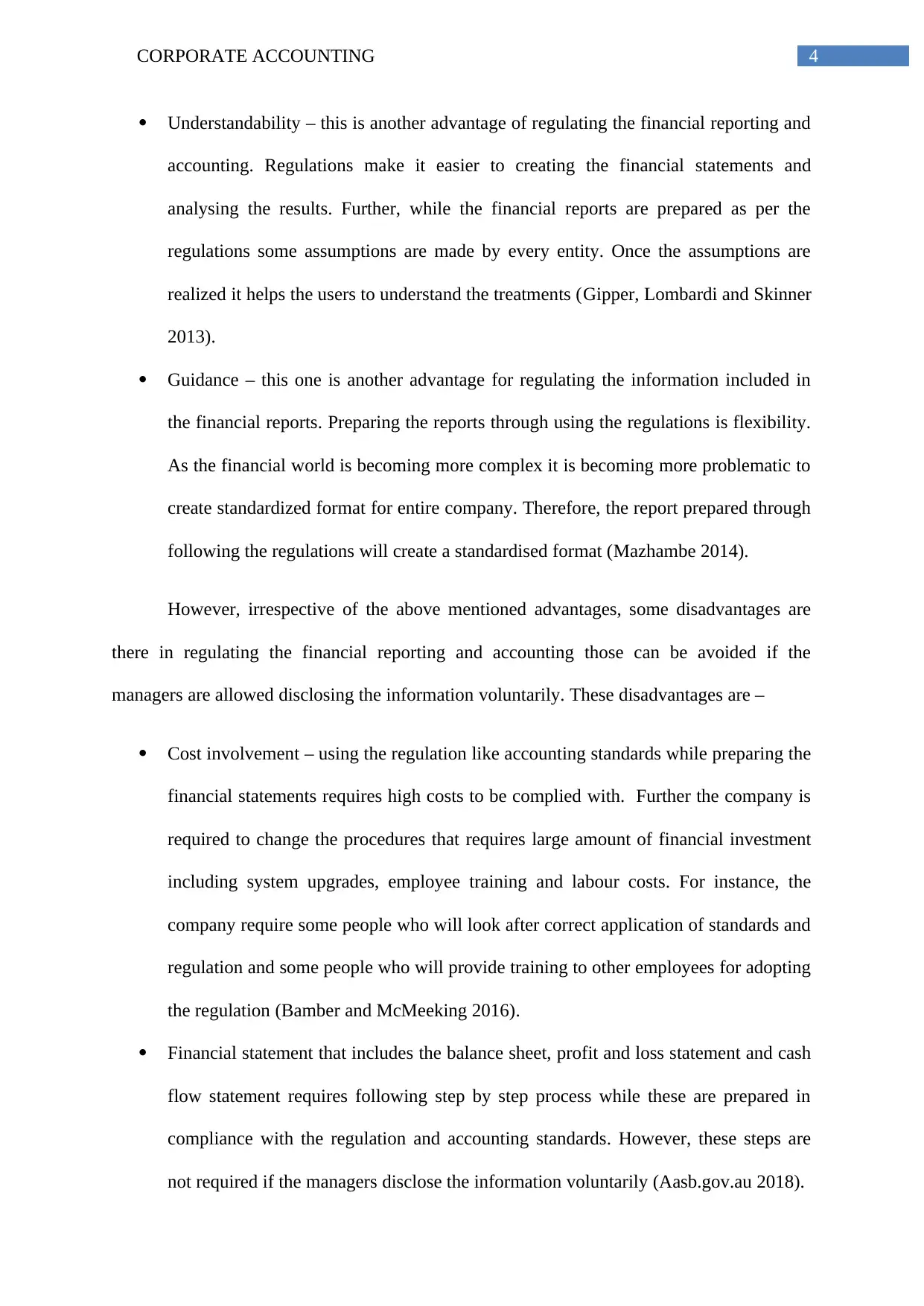
4CORPORATE ACCOUNTING
Understandability – this is another advantage of regulating the financial reporting and
accounting. Regulations make it easier to creating the financial statements and
analysing the results. Further, while the financial reports are prepared as per the
regulations some assumptions are made by every entity. Once the assumptions are
realized it helps the users to understand the treatments (Gipper, Lombardi and Skinner
2013).
Guidance – this one is another advantage for regulating the information included in
the financial reports. Preparing the reports through using the regulations is flexibility.
As the financial world is becoming more complex it is becoming more problematic to
create standardized format for entire company. Therefore, the report prepared through
following the regulations will create a standardised format (Mazhambe 2014).
However, irrespective of the above mentioned advantages, some disadvantages are
there in regulating the financial reporting and accounting those can be avoided if the
managers are allowed disclosing the information voluntarily. These disadvantages are –
Cost involvement – using the regulation like accounting standards while preparing the
financial statements requires high costs to be complied with. Further the company is
required to change the procedures that requires large amount of financial investment
including system upgrades, employee training and labour costs. For instance, the
company require some people who will look after correct application of standards and
regulation and some people who will provide training to other employees for adopting
the regulation (Bamber and McMeeking 2016).
Financial statement that includes the balance sheet, profit and loss statement and cash
flow statement requires following step by step process while these are prepared in
compliance with the regulation and accounting standards. However, these steps are
not required if the managers disclose the information voluntarily (Aasb.gov.au 2018).
Understandability – this is another advantage of regulating the financial reporting and
accounting. Regulations make it easier to creating the financial statements and
analysing the results. Further, while the financial reports are prepared as per the
regulations some assumptions are made by every entity. Once the assumptions are
realized it helps the users to understand the treatments (Gipper, Lombardi and Skinner
2013).
Guidance – this one is another advantage for regulating the information included in
the financial reports. Preparing the reports through using the regulations is flexibility.
As the financial world is becoming more complex it is becoming more problematic to
create standardized format for entire company. Therefore, the report prepared through
following the regulations will create a standardised format (Mazhambe 2014).
However, irrespective of the above mentioned advantages, some disadvantages are
there in regulating the financial reporting and accounting those can be avoided if the
managers are allowed disclosing the information voluntarily. These disadvantages are –
Cost involvement – using the regulation like accounting standards while preparing the
financial statements requires high costs to be complied with. Further the company is
required to change the procedures that requires large amount of financial investment
including system upgrades, employee training and labour costs. For instance, the
company require some people who will look after correct application of standards and
regulation and some people who will provide training to other employees for adopting
the regulation (Bamber and McMeeking 2016).
Financial statement that includes the balance sheet, profit and loss statement and cash
flow statement requires following step by step process while these are prepared in
compliance with the regulation and accounting standards. However, these steps are
not required if the managers disclose the information voluntarily (Aasb.gov.au 2018).
Paraphrase This Document
Need a fresh take? Get an instant paraphrase of this document with our AI Paraphraser
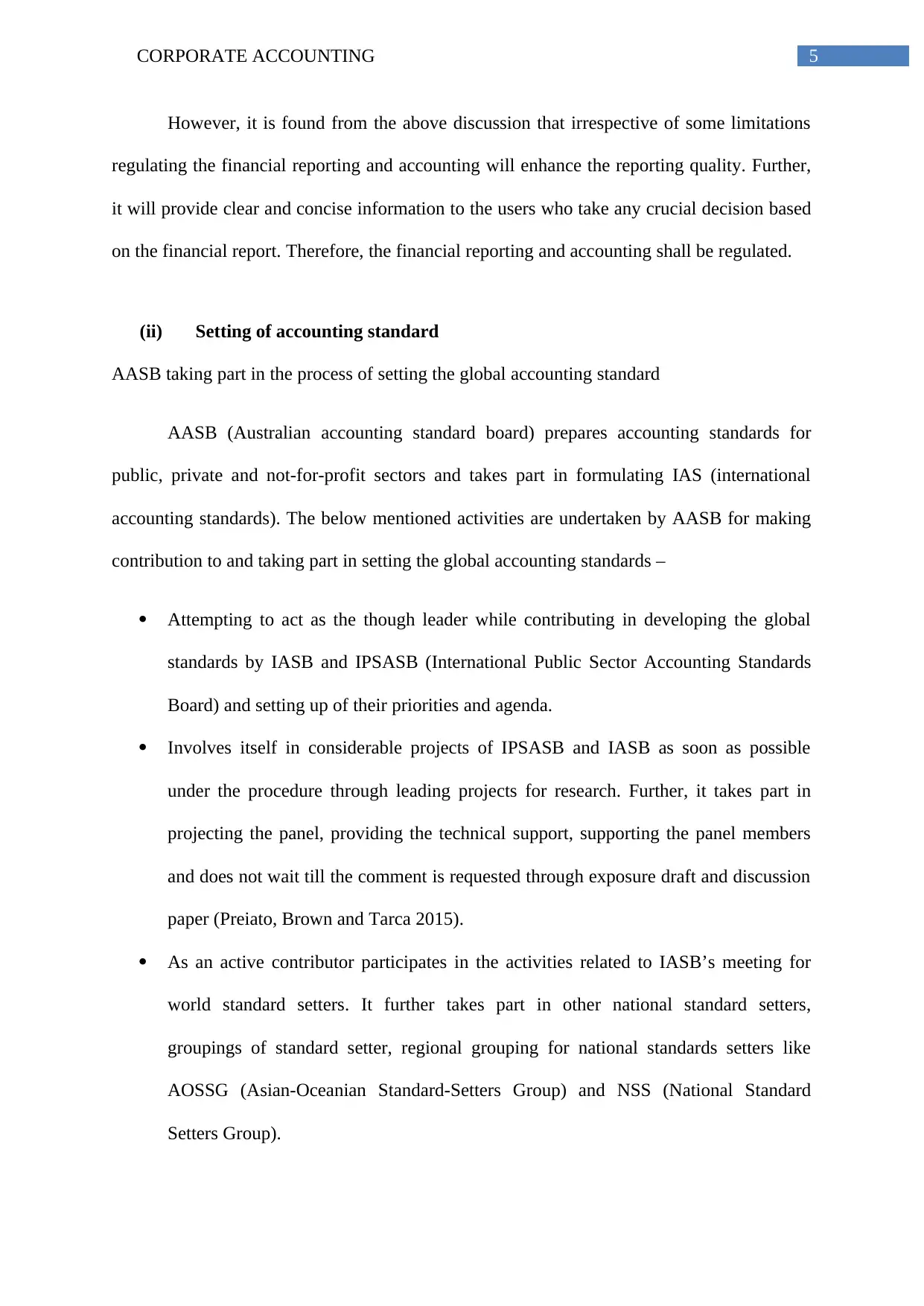
5CORPORATE ACCOUNTING
However, it is found from the above discussion that irrespective of some limitations
regulating the financial reporting and accounting will enhance the reporting quality. Further,
it will provide clear and concise information to the users who take any crucial decision based
on the financial report. Therefore, the financial reporting and accounting shall be regulated.
(ii) Setting of accounting standard
AASB taking part in the process of setting the global accounting standard
AASB (Australian accounting standard board) prepares accounting standards for
public, private and not-for-profit sectors and takes part in formulating IAS (international
accounting standards). The below mentioned activities are undertaken by AASB for making
contribution to and taking part in setting the global accounting standards –
Attempting to act as the though leader while contributing in developing the global
standards by IASB and IPSASB (International Public Sector Accounting Standards
Board) and setting up of their priorities and agenda.
Involves itself in considerable projects of IPSASB and IASB as soon as possible
under the procedure through leading projects for research. Further, it takes part in
projecting the panel, providing the technical support, supporting the panel members
and does not wait till the comment is requested through exposure draft and discussion
paper (Preiato, Brown and Tarca 2015).
As an active contributor participates in the activities related to IASB’s meeting for
world standard setters. It further takes part in other national standard setters,
groupings of standard setter, regional grouping for national standards setters like
AOSSG (Asian-Oceanian Standard-Setters Group) and NSS (National Standard
Setters Group).
However, it is found from the above discussion that irrespective of some limitations
regulating the financial reporting and accounting will enhance the reporting quality. Further,
it will provide clear and concise information to the users who take any crucial decision based
on the financial report. Therefore, the financial reporting and accounting shall be regulated.
(ii) Setting of accounting standard
AASB taking part in the process of setting the global accounting standard
AASB (Australian accounting standard board) prepares accounting standards for
public, private and not-for-profit sectors and takes part in formulating IAS (international
accounting standards). The below mentioned activities are undertaken by AASB for making
contribution to and taking part in setting the global accounting standards –
Attempting to act as the though leader while contributing in developing the global
standards by IASB and IPSASB (International Public Sector Accounting Standards
Board) and setting up of their priorities and agenda.
Involves itself in considerable projects of IPSASB and IASB as soon as possible
under the procedure through leading projects for research. Further, it takes part in
projecting the panel, providing the technical support, supporting the panel members
and does not wait till the comment is requested through exposure draft and discussion
paper (Preiato, Brown and Tarca 2015).
As an active contributor participates in the activities related to IASB’s meeting for
world standard setters. It further takes part in other national standard setters,
groupings of standard setter, regional grouping for national standards setters like
AOSSG (Asian-Oceanian Standard-Setters Group) and NSS (National Standard
Setters Group).
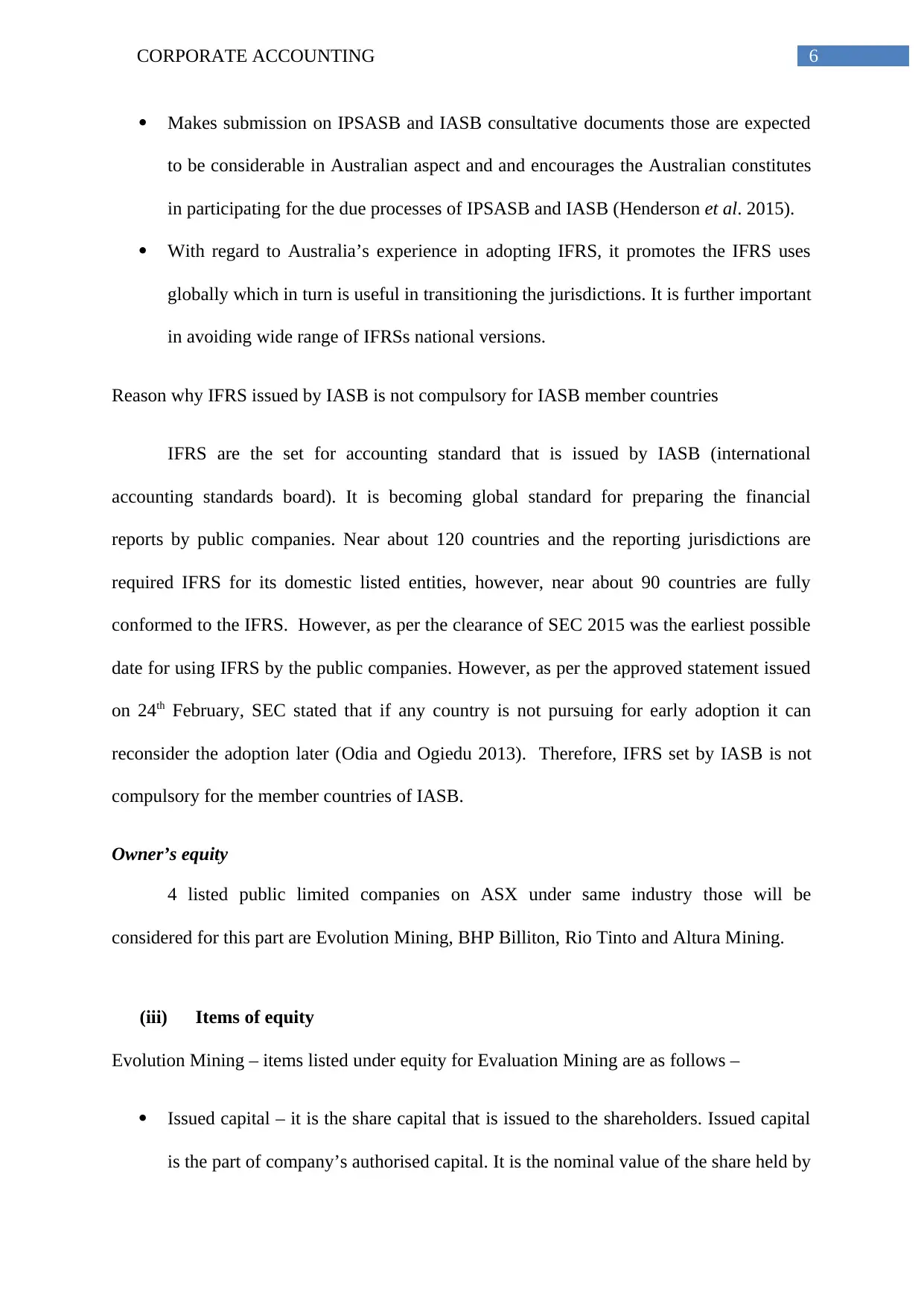
6CORPORATE ACCOUNTING
Makes submission on IPSASB and IASB consultative documents those are expected
to be considerable in Australian aspect and and encourages the Australian constitutes
in participating for the due processes of IPSASB and IASB (Henderson et al. 2015).
With regard to Australia’s experience in adopting IFRS, it promotes the IFRS uses
globally which in turn is useful in transitioning the jurisdictions. It is further important
in avoiding wide range of IFRSs national versions.
Reason why IFRS issued by IASB is not compulsory for IASB member countries
IFRS are the set for accounting standard that is issued by IASB (international
accounting standards board). It is becoming global standard for preparing the financial
reports by public companies. Near about 120 countries and the reporting jurisdictions are
required IFRS for its domestic listed entities, however, near about 90 countries are fully
conformed to the IFRS. However, as per the clearance of SEC 2015 was the earliest possible
date for using IFRS by the public companies. However, as per the approved statement issued
on 24th February, SEC stated that if any country is not pursuing for early adoption it can
reconsider the adoption later (Odia and Ogiedu 2013). Therefore, IFRS set by IASB is not
compulsory for the member countries of IASB.
Owner’s equity
4 listed public limited companies on ASX under same industry those will be
considered for this part are Evolution Mining, BHP Billiton, Rio Tinto and Altura Mining.
(iii) Items of equity
Evolution Mining – items listed under equity for Evaluation Mining are as follows –
Issued capital – it is the share capital that is issued to the shareholders. Issued capital
is the part of company’s authorised capital. It is the nominal value of the share held by
Makes submission on IPSASB and IASB consultative documents those are expected
to be considerable in Australian aspect and and encourages the Australian constitutes
in participating for the due processes of IPSASB and IASB (Henderson et al. 2015).
With regard to Australia’s experience in adopting IFRS, it promotes the IFRS uses
globally which in turn is useful in transitioning the jurisdictions. It is further important
in avoiding wide range of IFRSs national versions.
Reason why IFRS issued by IASB is not compulsory for IASB member countries
IFRS are the set for accounting standard that is issued by IASB (international
accounting standards board). It is becoming global standard for preparing the financial
reports by public companies. Near about 120 countries and the reporting jurisdictions are
required IFRS for its domestic listed entities, however, near about 90 countries are fully
conformed to the IFRS. However, as per the clearance of SEC 2015 was the earliest possible
date for using IFRS by the public companies. However, as per the approved statement issued
on 24th February, SEC stated that if any country is not pursuing for early adoption it can
reconsider the adoption later (Odia and Ogiedu 2013). Therefore, IFRS set by IASB is not
compulsory for the member countries of IASB.
Owner’s equity
4 listed public limited companies on ASX under same industry those will be
considered for this part are Evolution Mining, BHP Billiton, Rio Tinto and Altura Mining.
(iii) Items of equity
Evolution Mining – items listed under equity for Evaluation Mining are as follows –
Issued capital – it is the share capital that is issued to the shareholders. Issued capital
is the part of company’s authorised capital. It is the nominal value of the share held by
⊘ This is a preview!⊘
Do you want full access?
Subscribe today to unlock all pages.

Trusted by 1+ million students worldwide
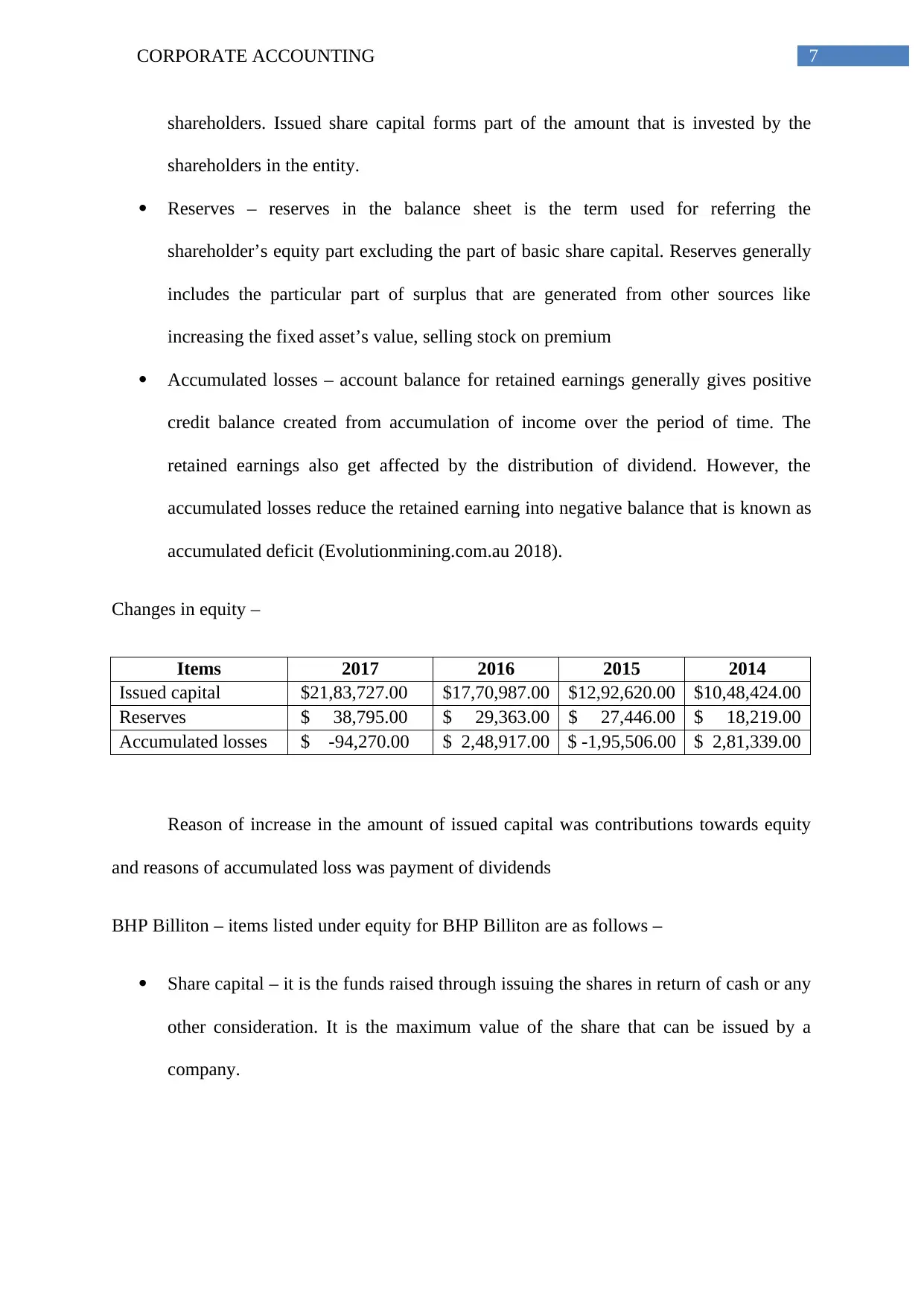
7CORPORATE ACCOUNTING
shareholders. Issued share capital forms part of the amount that is invested by the
shareholders in the entity.
Reserves – reserves in the balance sheet is the term used for referring the
shareholder’s equity part excluding the part of basic share capital. Reserves generally
includes the particular part of surplus that are generated from other sources like
increasing the fixed asset’s value, selling stock on premium
Accumulated losses – account balance for retained earnings generally gives positive
credit balance created from accumulation of income over the period of time. The
retained earnings also get affected by the distribution of dividend. However, the
accumulated losses reduce the retained earning into negative balance that is known as
accumulated deficit (Evolutionmining.com.au 2018).
Changes in equity –
Items 2017 2016 2015 2014
Issued capital $21,83,727.00 $17,70,987.00 $12,92,620.00 $10,48,424.00
Reserves $ 38,795.00 $ 29,363.00 $ 27,446.00 $ 18,219.00
Accumulated losses $ -94,270.00 $ 2,48,917.00 $ -1,95,506.00 $ 2,81,339.00
Reason of increase in the amount of issued capital was contributions towards equity
and reasons of accumulated loss was payment of dividends
BHP Billiton – items listed under equity for BHP Billiton are as follows –
Share capital – it is the funds raised through issuing the shares in return of cash or any
other consideration. It is the maximum value of the share that can be issued by a
company.
shareholders. Issued share capital forms part of the amount that is invested by the
shareholders in the entity.
Reserves – reserves in the balance sheet is the term used for referring the
shareholder’s equity part excluding the part of basic share capital. Reserves generally
includes the particular part of surplus that are generated from other sources like
increasing the fixed asset’s value, selling stock on premium
Accumulated losses – account balance for retained earnings generally gives positive
credit balance created from accumulation of income over the period of time. The
retained earnings also get affected by the distribution of dividend. However, the
accumulated losses reduce the retained earning into negative balance that is known as
accumulated deficit (Evolutionmining.com.au 2018).
Changes in equity –
Items 2017 2016 2015 2014
Issued capital $21,83,727.00 $17,70,987.00 $12,92,620.00 $10,48,424.00
Reserves $ 38,795.00 $ 29,363.00 $ 27,446.00 $ 18,219.00
Accumulated losses $ -94,270.00 $ 2,48,917.00 $ -1,95,506.00 $ 2,81,339.00
Reason of increase in the amount of issued capital was contributions towards equity
and reasons of accumulated loss was payment of dividends
BHP Billiton – items listed under equity for BHP Billiton are as follows –
Share capital – it is the funds raised through issuing the shares in return of cash or any
other consideration. It is the maximum value of the share that can be issued by a
company.
Paraphrase This Document
Need a fresh take? Get an instant paraphrase of this document with our AI Paraphraser
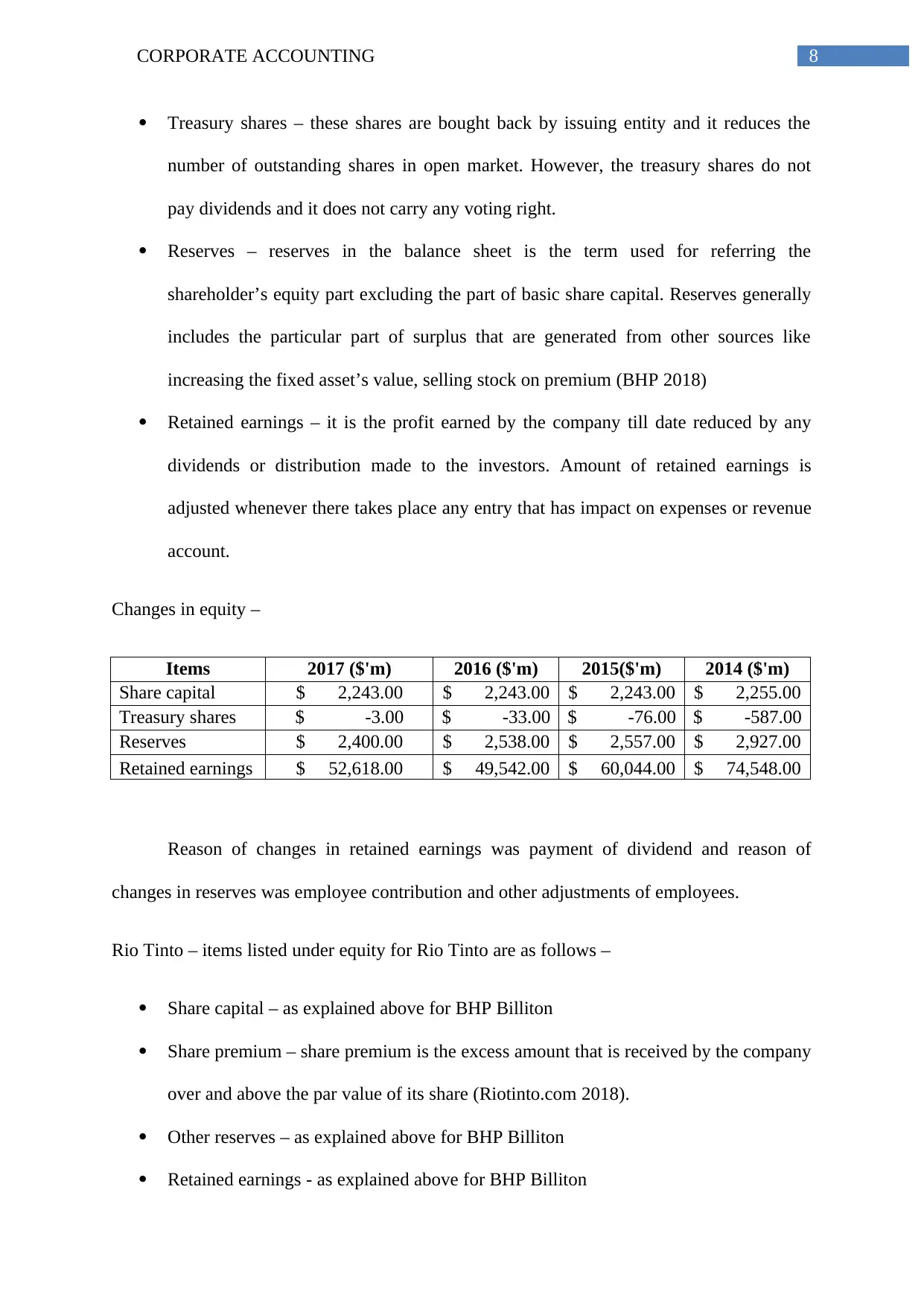
8CORPORATE ACCOUNTING
Treasury shares – these shares are bought back by issuing entity and it reduces the
number of outstanding shares in open market. However, the treasury shares do not
pay dividends and it does not carry any voting right.
Reserves – reserves in the balance sheet is the term used for referring the
shareholder’s equity part excluding the part of basic share capital. Reserves generally
includes the particular part of surplus that are generated from other sources like
increasing the fixed asset’s value, selling stock on premium (BHP 2018)
Retained earnings – it is the profit earned by the company till date reduced by any
dividends or distribution made to the investors. Amount of retained earnings is
adjusted whenever there takes place any entry that has impact on expenses or revenue
account.
Changes in equity –
Items 2017 ($'m) 2016 ($'m) 2015($'m) 2014 ($'m)
Share capital $ 2,243.00 $ 2,243.00 $ 2,243.00 $ 2,255.00
Treasury shares $ -3.00 $ -33.00 $ -76.00 $ -587.00
Reserves $ 2,400.00 $ 2,538.00 $ 2,557.00 $ 2,927.00
Retained earnings $ 52,618.00 $ 49,542.00 $ 60,044.00 $ 74,548.00
Reason of changes in retained earnings was payment of dividend and reason of
changes in reserves was employee contribution and other adjustments of employees.
Rio Tinto – items listed under equity for Rio Tinto are as follows –
Share capital – as explained above for BHP Billiton
Share premium – share premium is the excess amount that is received by the company
over and above the par value of its share (Riotinto.com 2018).
Other reserves – as explained above for BHP Billiton
Retained earnings - as explained above for BHP Billiton
Treasury shares – these shares are bought back by issuing entity and it reduces the
number of outstanding shares in open market. However, the treasury shares do not
pay dividends and it does not carry any voting right.
Reserves – reserves in the balance sheet is the term used for referring the
shareholder’s equity part excluding the part of basic share capital. Reserves generally
includes the particular part of surplus that are generated from other sources like
increasing the fixed asset’s value, selling stock on premium (BHP 2018)
Retained earnings – it is the profit earned by the company till date reduced by any
dividends or distribution made to the investors. Amount of retained earnings is
adjusted whenever there takes place any entry that has impact on expenses or revenue
account.
Changes in equity –
Items 2017 ($'m) 2016 ($'m) 2015($'m) 2014 ($'m)
Share capital $ 2,243.00 $ 2,243.00 $ 2,243.00 $ 2,255.00
Treasury shares $ -3.00 $ -33.00 $ -76.00 $ -587.00
Reserves $ 2,400.00 $ 2,538.00 $ 2,557.00 $ 2,927.00
Retained earnings $ 52,618.00 $ 49,542.00 $ 60,044.00 $ 74,548.00
Reason of changes in retained earnings was payment of dividend and reason of
changes in reserves was employee contribution and other adjustments of employees.
Rio Tinto – items listed under equity for Rio Tinto are as follows –
Share capital – as explained above for BHP Billiton
Share premium – share premium is the excess amount that is received by the company
over and above the par value of its share (Riotinto.com 2018).
Other reserves – as explained above for BHP Billiton
Retained earnings - as explained above for BHP Billiton
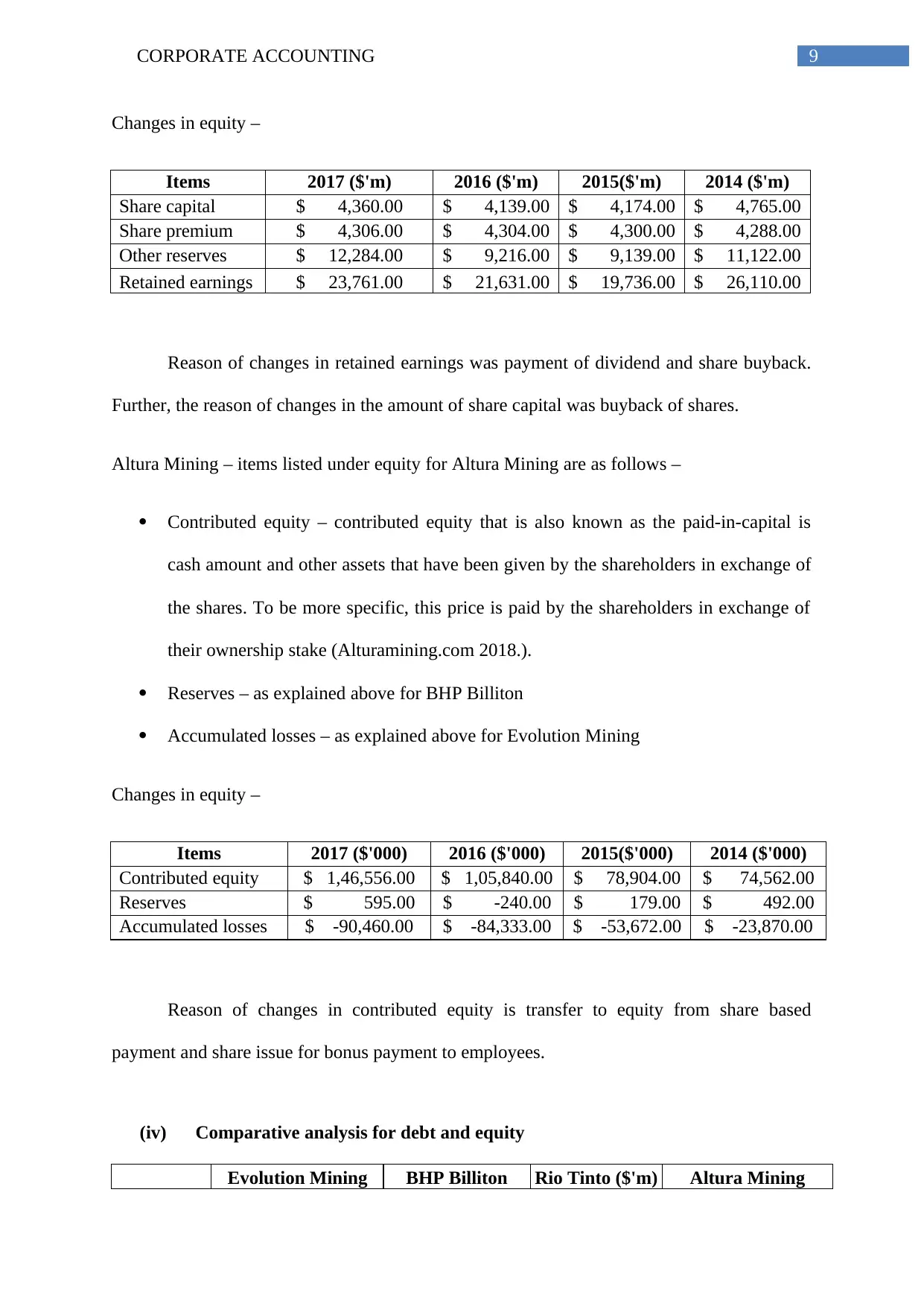
9CORPORATE ACCOUNTING
Changes in equity –
Items 2017 ($'m) 2016 ($'m) 2015($'m) 2014 ($'m)
Share capital $ 4,360.00 $ 4,139.00 $ 4,174.00 $ 4,765.00
Share premium $ 4,306.00 $ 4,304.00 $ 4,300.00 $ 4,288.00
Other reserves $ 12,284.00 $ 9,216.00 $ 9,139.00 $ 11,122.00
Retained earnings $ 23,761.00 $ 21,631.00 $ 19,736.00 $ 26,110.00
Reason of changes in retained earnings was payment of dividend and share buyback.
Further, the reason of changes in the amount of share capital was buyback of shares.
Altura Mining – items listed under equity for Altura Mining are as follows –
Contributed equity – contributed equity that is also known as the paid-in-capital is
cash amount and other assets that have been given by the shareholders in exchange of
the shares. To be more specific, this price is paid by the shareholders in exchange of
their ownership stake (Alturamining.com 2018.).
Reserves – as explained above for BHP Billiton
Accumulated losses – as explained above for Evolution Mining
Changes in equity –
Items 2017 ($'000) 2016 ($'000) 2015($'000) 2014 ($'000)
Contributed equity $ 1,46,556.00 $ 1,05,840.00 $ 78,904.00 $ 74,562.00
Reserves $ 595.00 $ -240.00 $ 179.00 $ 492.00
Accumulated losses $ -90,460.00 $ -84,333.00 $ -53,672.00 $ -23,870.00
Reason of changes in contributed equity is transfer to equity from share based
payment and share issue for bonus payment to employees.
(iv) Comparative analysis for debt and equity
Evolution Mining BHP Billiton Rio Tinto ($'m) Altura Mining
Changes in equity –
Items 2017 ($'m) 2016 ($'m) 2015($'m) 2014 ($'m)
Share capital $ 4,360.00 $ 4,139.00 $ 4,174.00 $ 4,765.00
Share premium $ 4,306.00 $ 4,304.00 $ 4,300.00 $ 4,288.00
Other reserves $ 12,284.00 $ 9,216.00 $ 9,139.00 $ 11,122.00
Retained earnings $ 23,761.00 $ 21,631.00 $ 19,736.00 $ 26,110.00
Reason of changes in retained earnings was payment of dividend and share buyback.
Further, the reason of changes in the amount of share capital was buyback of shares.
Altura Mining – items listed under equity for Altura Mining are as follows –
Contributed equity – contributed equity that is also known as the paid-in-capital is
cash amount and other assets that have been given by the shareholders in exchange of
the shares. To be more specific, this price is paid by the shareholders in exchange of
their ownership stake (Alturamining.com 2018.).
Reserves – as explained above for BHP Billiton
Accumulated losses – as explained above for Evolution Mining
Changes in equity –
Items 2017 ($'000) 2016 ($'000) 2015($'000) 2014 ($'000)
Contributed equity $ 1,46,556.00 $ 1,05,840.00 $ 78,904.00 $ 74,562.00
Reserves $ 595.00 $ -240.00 $ 179.00 $ 492.00
Accumulated losses $ -90,460.00 $ -84,333.00 $ -53,672.00 $ -23,870.00
Reason of changes in contributed equity is transfer to equity from share based
payment and share issue for bonus payment to employees.
(iv) Comparative analysis for debt and equity
Evolution Mining BHP Billiton Rio Tinto ($'m) Altura Mining
⊘ This is a preview!⊘
Do you want full access?
Subscribe today to unlock all pages.

Trusted by 1+ million students worldwide
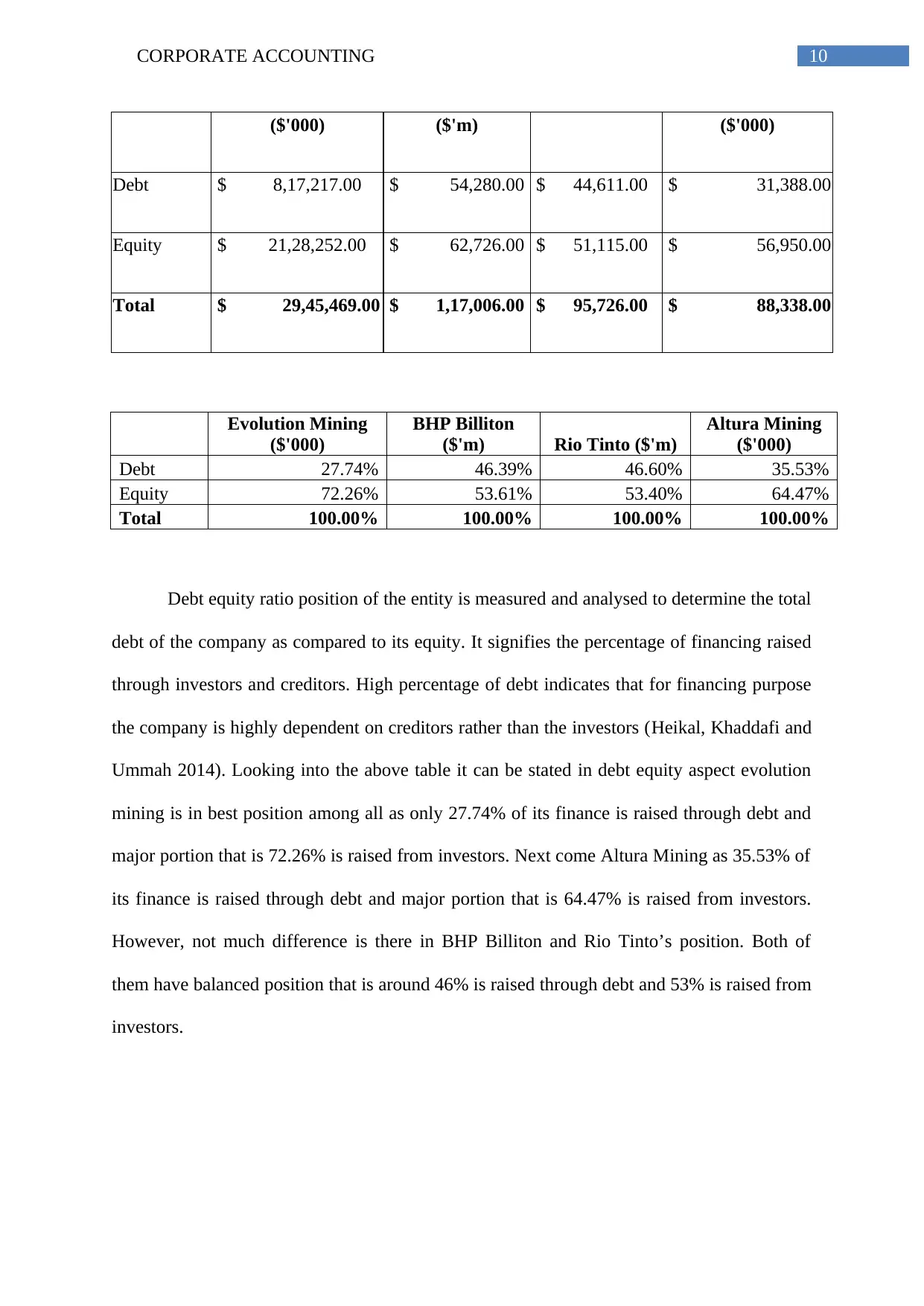
10CORPORATE ACCOUNTING
($'000) ($'m) ($'000)
Debt $ 8,17,217.00 $ 54,280.00 $ 44,611.00 $ 31,388.00
Equity $ 21,28,252.00 $ 62,726.00 $ 51,115.00 $ 56,950.00
Total $ 29,45,469.00 $ 1,17,006.00 $ 95,726.00 $ 88,338.00
Evolution Mining
($'000)
BHP Billiton
($'m) Rio Tinto ($'m)
Altura Mining
($'000)
Debt 27.74% 46.39% 46.60% 35.53%
Equity 72.26% 53.61% 53.40% 64.47%
Total 100.00% 100.00% 100.00% 100.00%
Debt equity ratio position of the entity is measured and analysed to determine the total
debt of the company as compared to its equity. It signifies the percentage of financing raised
through investors and creditors. High percentage of debt indicates that for financing purpose
the company is highly dependent on creditors rather than the investors (Heikal, Khaddafi and
Ummah 2014). Looking into the above table it can be stated in debt equity aspect evolution
mining is in best position among all as only 27.74% of its finance is raised through debt and
major portion that is 72.26% is raised from investors. Next come Altura Mining as 35.53% of
its finance is raised through debt and major portion that is 64.47% is raised from investors.
However, not much difference is there in BHP Billiton and Rio Tinto’s position. Both of
them have balanced position that is around 46% is raised through debt and 53% is raised from
investors.
($'000) ($'m) ($'000)
Debt $ 8,17,217.00 $ 54,280.00 $ 44,611.00 $ 31,388.00
Equity $ 21,28,252.00 $ 62,726.00 $ 51,115.00 $ 56,950.00
Total $ 29,45,469.00 $ 1,17,006.00 $ 95,726.00 $ 88,338.00
Evolution Mining
($'000)
BHP Billiton
($'m) Rio Tinto ($'m)
Altura Mining
($'000)
Debt 27.74% 46.39% 46.60% 35.53%
Equity 72.26% 53.61% 53.40% 64.47%
Total 100.00% 100.00% 100.00% 100.00%
Debt equity ratio position of the entity is measured and analysed to determine the total
debt of the company as compared to its equity. It signifies the percentage of financing raised
through investors and creditors. High percentage of debt indicates that for financing purpose
the company is highly dependent on creditors rather than the investors (Heikal, Khaddafi and
Ummah 2014). Looking into the above table it can be stated in debt equity aspect evolution
mining is in best position among all as only 27.74% of its finance is raised through debt and
major portion that is 72.26% is raised from investors. Next come Altura Mining as 35.53% of
its finance is raised through debt and major portion that is 64.47% is raised from investors.
However, not much difference is there in BHP Billiton and Rio Tinto’s position. Both of
them have balanced position that is around 46% is raised through debt and 53% is raised from
investors.
Paraphrase This Document
Need a fresh take? Get an instant paraphrase of this document with our AI Paraphraser
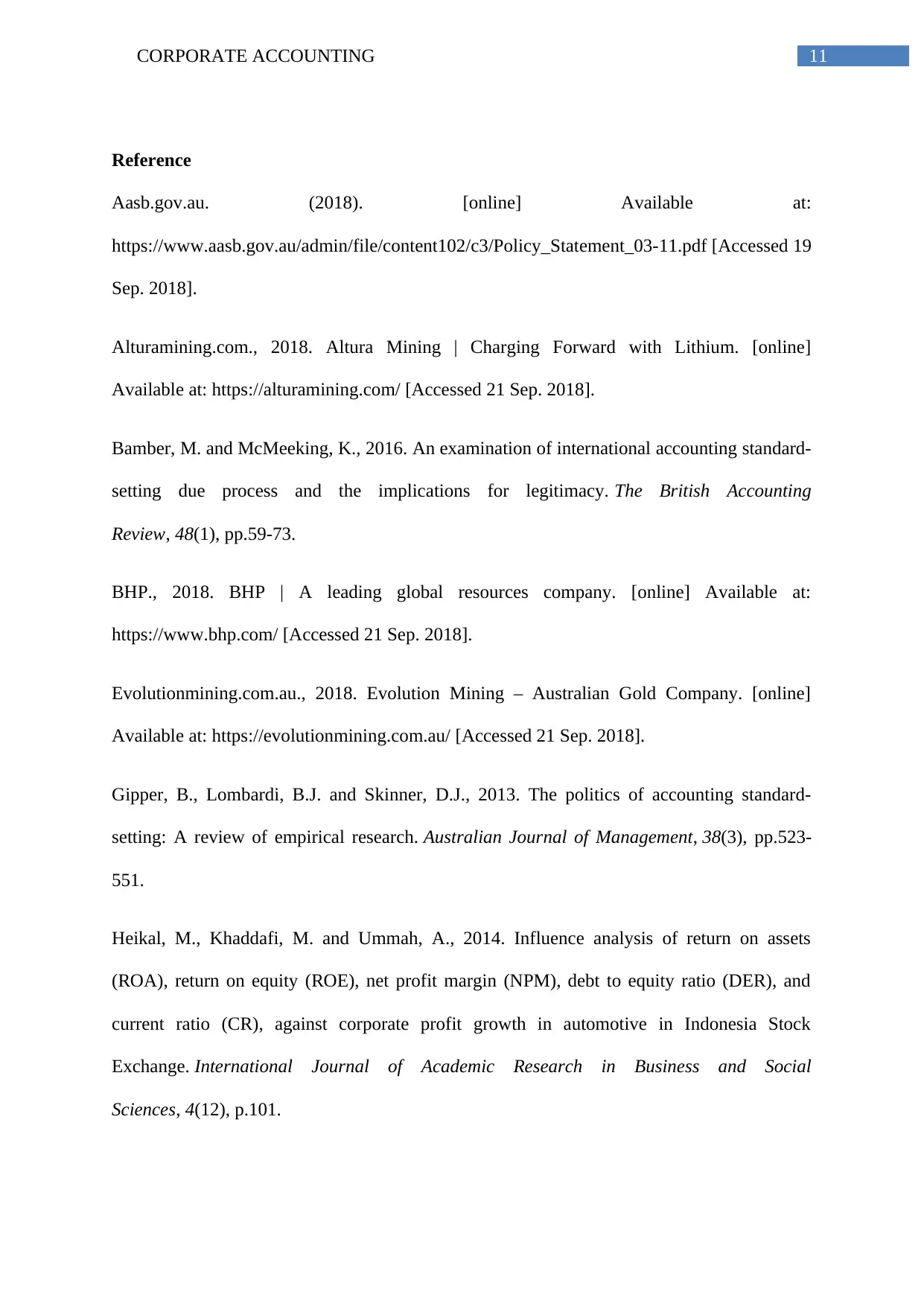
11CORPORATE ACCOUNTING
Reference
Aasb.gov.au. (2018). [online] Available at:
https://www.aasb.gov.au/admin/file/content102/c3/Policy_Statement_03-11.pdf [Accessed 19
Sep. 2018].
Alturamining.com., 2018. Altura Mining | Charging Forward with Lithium. [online]
Available at: https://alturamining.com/ [Accessed 21 Sep. 2018].
Bamber, M. and McMeeking, K., 2016. An examination of international accounting standard-
setting due process and the implications for legitimacy. The British Accounting
Review, 48(1), pp.59-73.
BHP., 2018. BHP | A leading global resources company. [online] Available at:
https://www.bhp.com/ [Accessed 21 Sep. 2018].
Evolutionmining.com.au., 2018. Evolution Mining – Australian Gold Company. [online]
Available at: https://evolutionmining.com.au/ [Accessed 21 Sep. 2018].
Gipper, B., Lombardi, B.J. and Skinner, D.J., 2013. The politics of accounting standard-
setting: A review of empirical research. Australian Journal of Management, 38(3), pp.523-
551.
Heikal, M., Khaddafi, M. and Ummah, A., 2014. Influence analysis of return on assets
(ROA), return on equity (ROE), net profit margin (NPM), debt to equity ratio (DER), and
current ratio (CR), against corporate profit growth in automotive in Indonesia Stock
Exchange. International Journal of Academic Research in Business and Social
Sciences, 4(12), p.101.
Reference
Aasb.gov.au. (2018). [online] Available at:
https://www.aasb.gov.au/admin/file/content102/c3/Policy_Statement_03-11.pdf [Accessed 19
Sep. 2018].
Alturamining.com., 2018. Altura Mining | Charging Forward with Lithium. [online]
Available at: https://alturamining.com/ [Accessed 21 Sep. 2018].
Bamber, M. and McMeeking, K., 2016. An examination of international accounting standard-
setting due process and the implications for legitimacy. The British Accounting
Review, 48(1), pp.59-73.
BHP., 2018. BHP | A leading global resources company. [online] Available at:
https://www.bhp.com/ [Accessed 21 Sep. 2018].
Evolutionmining.com.au., 2018. Evolution Mining – Australian Gold Company. [online]
Available at: https://evolutionmining.com.au/ [Accessed 21 Sep. 2018].
Gipper, B., Lombardi, B.J. and Skinner, D.J., 2013. The politics of accounting standard-
setting: A review of empirical research. Australian Journal of Management, 38(3), pp.523-
551.
Heikal, M., Khaddafi, M. and Ummah, A., 2014. Influence analysis of return on assets
(ROA), return on equity (ROE), net profit margin (NPM), debt to equity ratio (DER), and
current ratio (CR), against corporate profit growth in automotive in Indonesia Stock
Exchange. International Journal of Academic Research in Business and Social
Sciences, 4(12), p.101.
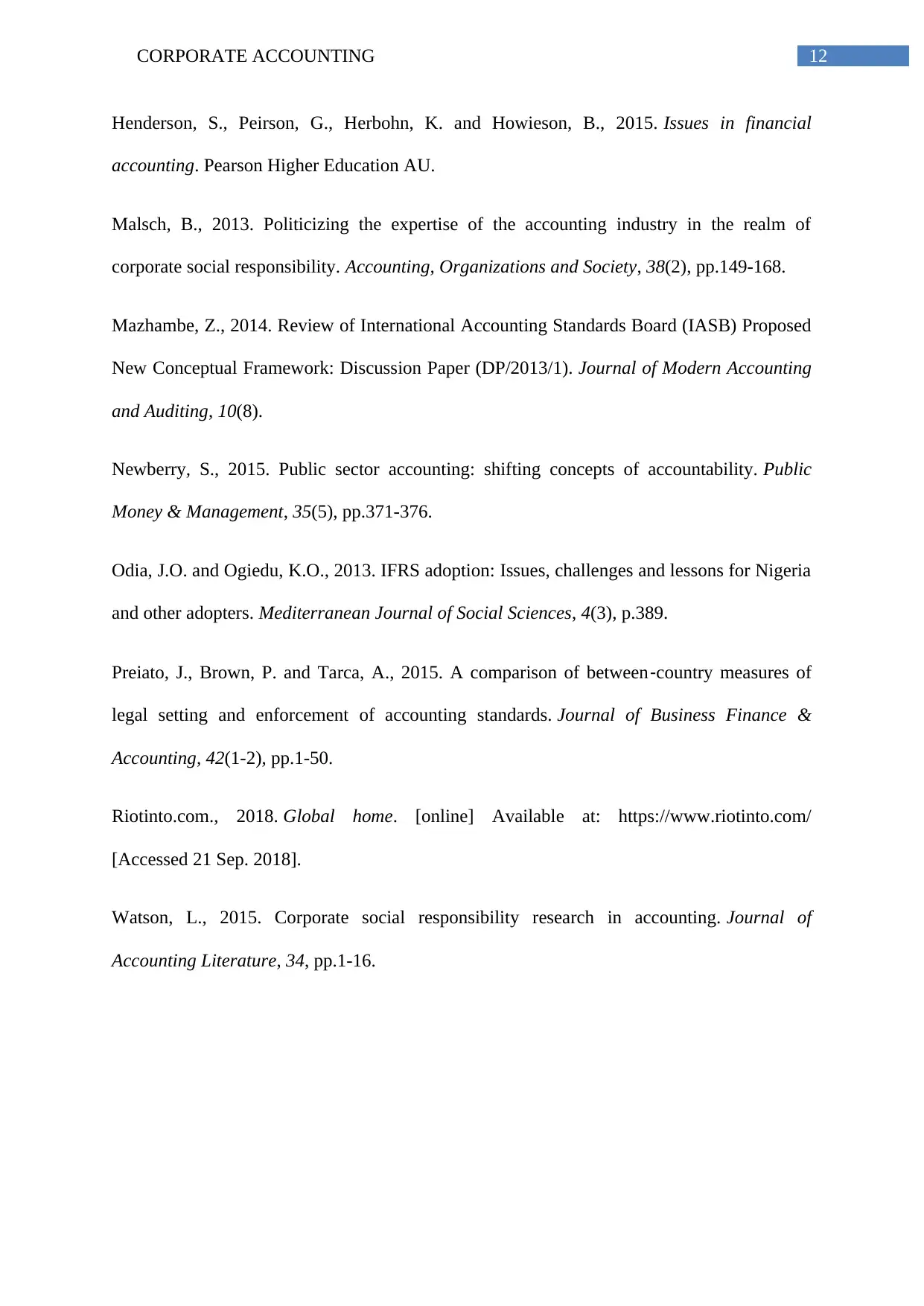
12CORPORATE ACCOUNTING
Henderson, S., Peirson, G., Herbohn, K. and Howieson, B., 2015. Issues in financial
accounting. Pearson Higher Education AU.
Malsch, B., 2013. Politicizing the expertise of the accounting industry in the realm of
corporate social responsibility. Accounting, Organizations and Society, 38(2), pp.149-168.
Mazhambe, Z., 2014. Review of International Accounting Standards Board (IASB) Proposed
New Conceptual Framework: Discussion Paper (DP/2013/1). Journal of Modern Accounting
and Auditing, 10(8).
Newberry, S., 2015. Public sector accounting: shifting concepts of accountability. Public
Money & Management, 35(5), pp.371-376.
Odia, J.O. and Ogiedu, K.O., 2013. IFRS adoption: Issues, challenges and lessons for Nigeria
and other adopters. Mediterranean Journal of Social Sciences, 4(3), p.389.
Preiato, J., Brown, P. and Tarca, A., 2015. A comparison of between‐country measures of
legal setting and enforcement of accounting standards. Journal of Business Finance &
Accounting, 42(1-2), pp.1-50.
Riotinto.com., 2018. Global home. [online] Available at: https://www.riotinto.com/
[Accessed 21 Sep. 2018].
Watson, L., 2015. Corporate social responsibility research in accounting. Journal of
Accounting Literature, 34, pp.1-16.
Henderson, S., Peirson, G., Herbohn, K. and Howieson, B., 2015. Issues in financial
accounting. Pearson Higher Education AU.
Malsch, B., 2013. Politicizing the expertise of the accounting industry in the realm of
corporate social responsibility. Accounting, Organizations and Society, 38(2), pp.149-168.
Mazhambe, Z., 2014. Review of International Accounting Standards Board (IASB) Proposed
New Conceptual Framework: Discussion Paper (DP/2013/1). Journal of Modern Accounting
and Auditing, 10(8).
Newberry, S., 2015. Public sector accounting: shifting concepts of accountability. Public
Money & Management, 35(5), pp.371-376.
Odia, J.O. and Ogiedu, K.O., 2013. IFRS adoption: Issues, challenges and lessons for Nigeria
and other adopters. Mediterranean Journal of Social Sciences, 4(3), p.389.
Preiato, J., Brown, P. and Tarca, A., 2015. A comparison of between‐country measures of
legal setting and enforcement of accounting standards. Journal of Business Finance &
Accounting, 42(1-2), pp.1-50.
Riotinto.com., 2018. Global home. [online] Available at: https://www.riotinto.com/
[Accessed 21 Sep. 2018].
Watson, L., 2015. Corporate social responsibility research in accounting. Journal of
Accounting Literature, 34, pp.1-16.
⊘ This is a preview!⊘
Do you want full access?
Subscribe today to unlock all pages.

Trusted by 1+ million students worldwide
1 out of 12
Related Documents
Your All-in-One AI-Powered Toolkit for Academic Success.
+13062052269
info@desklib.com
Available 24*7 on WhatsApp / Email
![[object Object]](/_next/static/media/star-bottom.7253800d.svg)
Unlock your academic potential
Copyright © 2020–2025 A2Z Services. All Rights Reserved. Developed and managed by ZUCOL.




